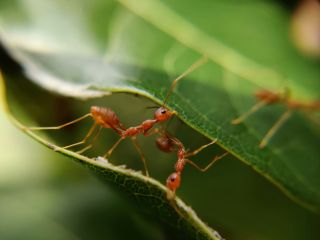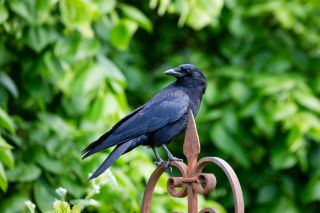Animal Behavior
Are Animals Conscious?
What science says about the minds and experiences of other animal species.
Posted June 12, 2024 Reviewed by Devon Frye
Key points
- We cannot definitively say what animals experience, but there is evidence that many species are conscious.
- Early modern philosophers thought that animals are mere biological machines or automata without a mind.
- Research shows that many animals, including invertebrates like ants, have some self-awareness.
- Leading scientists have signed declarations stating that consciousness is likely widespread among animals.

Researchers have found that looking at a picture of a pet can reduce stress (Ein et al., 2019) and trigger a strong neural and physiological response (Hayama et al., 2016; Nagasawa et al., 2009), highlighting our affection for them. Do pets feel the same way towards us? Do they experience emotions the way we do? Do they experience anything at all?
Mere Machines?
Although we are sentient beings, many of our actions seem to occur automatically: We have reflexes, can walk or drive along a familiar route without much thought, or complete parts of our daily routine—like brushing our teeth—without actively paying attention.
One of the most influential early modern philosophers, René Descartes, believed that all animal behaviour is merely automatic. He described them as automata, like machines without minds (Thomas, 2020). Some subsequent thinkers even suggested that animals have neither desires nor fears, know nothing, and experience nothing—neither pleasure nor pain (Harrison, 1992).
These ideas may seem absurd to anyone who has spent sufficient time around animals. At the same time, it is unclear to what extent animals experience the world and whether this differs by species.
From Philosophy to Science
These questions are extremely difficult to answer, largely because our understanding of consciousness is still in its infancy. Every experience we ever had, every memory, every thought, and every feeling is and has been mediated by our own consciousness (see Pang, 2023a, 2023b). Even though consciousness is at the centre of what makes us human, we still do not fully know what consciousness is or what its underlying mechanisms are.
That is why these questions have been in the domain of philosophy for centuries. However, science is slowly catching up and has made dramatic strides in recent decades (see Pang, 2023c). We have linked distinct brain functions to experiences (so-called neural correlates of consciousness; Koch et al., 2016; Nani et al., 2019) and have found many new ways to investigate this elusive phenomenon (Dehaene, 2014).
Despite these advances, there is still a lot we do not yet know. Some have suggested we may never know—at least not with our current approaches to neuroscience (Chalmers, 1995). Although we do not have definitive answers (yet), we can draw some informed preliminary conclusions that point towards animals being far more than mere mindless machines.

There is evidence that many animals recognise themselves in a mirror, including elephants (Plotnik et al., 2016), magpies (Prior et al., 2008), and even ants (Lei, 2022). While such mirror tests have been controversial as measures of self-awareness, there are indications that this method underestimates levels of self-awareness (Koerth-Baker, 2010). This sense of self may be different in animals than in humans. One researcher, for example, has suggested that only humans have a true sense of an "I-ness" while animals merely have a sense of "body-ness" or "mine-ness" (Bekoff, 2002), but this is difficult to establish.
Other lines of research have given strong reasons to believe that animals can ascribe mental states to other beings, such as being aware of other animals' desires or intentions (Krupenye & Call, 2019). One remarkable example is the finding that ravens guard hidden food stores against discovery when hearing sounds of other birds through a peephole, which gives them visual access, but not if the sound comes from a closed peephole (Bugnyar et al., 2016). In other words, ravens understand whether other birds in the vicinity have an opportunity to observe them or not.
Researchers have also found that bees roll balls simply for fun (Dona et al., 2022), and some primates even have a sense of humour and joke among themselves (Laumer et al., 2024).

Animal Consciousness
Although there is no definitive proof, these findings all point at least towards some form of awareness in animals.
All these behaviours could occur without awareness, just like a video game character can show human-like behaviour based on coding algorithms without requiring any consciousness. However, animal behaviour often closely resembles our own behaviour mediated by consciousness. Given the lack of evidence that they do not have a mind or experiences but show forms of awareness and mental functions, the current evidence favours the notion that animals have conscious experiences.
While the level of consciousness may differ between species, there is a growing consensus among scientists that animals are indeed conscious (Birch et al., 2020). In 2012, a group of leading researchers signed the Cambridge Declaration on Consciousness (Low, 2012), declaring that many non-human animals—even those without a neocortex—have all the biologically necessary substrates to generate conscious states. More recently, another group went even further in the New York Declaration on Animal Consciousness, suggesting that there is strong scientific support for consciousness in mammals and birds and that there is at least a realistic possibility of conscious experiences in all vertebrates and even in many invertebrates, like molluscs, crustaceans, and insects (Andrews et al., 2024).
Conclusion
Are animals conscious? We cannot tell for sure, but there is converging evidence that many animals are aware of themselves, others, and even others' mental states. There is an emerging consensus among scientists that our pets and possibly even reptiles and insects may have some form of conscious awareness.
So, when your puppy seems excited to see you, there is a very high chance that this is not just an outward behavioural pattern but a true sense of affection felt within.
Facebook image: Magui RF/Shutterstock
References
Andrews, K., Birch, J., Sebo, J., & Sims. T. (2024). Background to the New York Declaration on Animal Consciousness. https://sites.google.com/nyu.edu/nydeclaration/background
Bekoff, M. (2002). Awareness: animal reflections. Nature, 419(6904), 255-255. https://doi.org/10.1038/419255a
Birch, J., Schnell, A. K., & Clayton, N. S. (2020). Dimensions of animal consciousness. Trends in cognitive sciences, 24(10), 789-801. https://doi.org/10.1016/j.tics.2020.07.007
Bugnyar, T., Reber, S. A., & Buckner, C. (2016). Ravens attribute visual access to unseen competitors. Nature communications, 7(1), 10506. https://doi.org/10.1038/ncomms10506
Chalmers, D. (1995). Facing up to the problem of consciousness. Journal of Consciousness Studies, 2(3), 200-219.
Dehaene, S. (2014). Consciousness and the brain: Deciphering how the brain codes our thoughts. London: Penguin Books.
Dona, H. S. G., Solvi, C., Kowalewska, A., Mäkelä, K., MaBouDi, H., & Chittka, L. (2022). Do bumble bees play?. Animal Behaviour, 194, 239-251. https://doi.org/10.1016/j.anbehav.2022.08.013
Ein, N., Hadad, M., Reed, M. J., & Vickers, K. (2019). Does viewing a picture of a pet during a mental arithmetic task lower stress levels? Anthrozoös, 32(4), 519-532. https://doi.org/10.1080/08927936.2019.1621524
Harrison, P. (1992). Descartes on animals. The Philosophical Quarterly, 42(167), 219-227. https://doi.org/10.2307/2220217
Hayama, S., Chang, L., Gumus, K., King, G. R., & Ernst, T. (2016). Neural correlates for perception of companion animal photographs. Neuropsychologia, 85, 278-286. https://doi.org/10.1016/j.neuropsychologia.2016.03.018
Koch, C., Massimini, M., Boly, M., & Tononi, G. (2016). Neural correlates of consciousness: progress and problems. Nature Reviews Neuroscience, 17(5), 307-321. https://doi.org/10.1038/nrn.2016.22
Koerth-Baker, M. (2010, Nov 29). Kids (and animals) who fail classic mirror tests may still have sens of self. Scientific American. https://www.scientificamerican.com/article/kids-and-animals-who-fail-classic-mirror/
Krupenye, C., & Call, J. (2019). Theory of mind in animals: Current and future directions. Wiley Interdisciplinary Reviews: Cognitive Science, 10(6), e1503. https://doi.org/10.1002/wcs.1503
Laumer, I. B., Winkler, S. L., Rossano, F., & Cartmill, E. A. (2024). Spontaneous playful teasing in four great ape species. Proceedings of the Royal Society B, 291(2016), 20232345. https://doi.org/10.1098/rspb.2023.2345
Lei, Y. (2023). Sociality and self-awareness in animals. Frontiers in Psychology, 13, 1065638. https://doi.org/10.3389%2Ffpsyg.2022.1065638
Low, P. (2012). The Cambridge Declaration on consciousness. Proceedings of the Francis Crick Memorial Conference, Churchill College, Cambridge University. https://fcmconference.org/img/CambridgeDeclarationOnConsciousness.pdf
Nagasawa, M., Kikusui, T., Onaka, T., & Ohta, M. (2009). Dog's gaze at its owner increases owner's urinary oxytocin during social interaction. Hormones and behavior, 55(3), 434-441. https://doi.org/10.1016/j.yhbeh.2008.12.002
Nani, A., Manuello, J., Mancuso, L., Liloia, D., Costa, T., & Cauda, F. (2019). The neural correlates of consciousness and attention: two sister processes of the brain. Frontiers in Neuroscience, 13, 487285. https://doi.org/10.3389/fnins.2019.01169
Pang, D. K. F. (2023a). What is consciousness? Psychology Today. https://www.psychologytoday.com/intl/blog/consciousness-and-beyond/202305/what-is-consciousness
Pang, D. K. F. (2023b). The many dimensions of consciousness. Psychology Today. https://www.psychologytoday.com/intl/blog/consciousness-and-beyond/202305/the-many-dimensions-of-consciousness
Pang, D. K. F. (2023c). The cognitive revolution: Unlocking the secrets of the mind. Psychology Today. https://www.psychologytoday.com/intl/blog/consciousness-and-beyond/202312/the-cognitive-revolution-unlocking-the-secrets-of-the-mind
Plotnik, J. M., De Waal, F. B., & Reiss, D. (2006). Self-recognition in an Asian elephant. Proceedings of the National Academy of Sciences, 103(45), 17053-17057. https://doi.org/10.1073%2Fpnas.0608062103
Prior, H., Schwarz, A., & Güntürkün, O. (2008). Mirror-induced behavior in the magpie (Pica pica): evidence of self-recognition. PLoS biology, 6(8), e202. https://doi.org/10.1371/journal.pbio.0060202
Thomas, E. (2020). Descartes on the animal within, and the animals without. Canadian Journal of Philosophy, 50(8), 999-1014. https://doi.org/10.1017/can.2020.44




